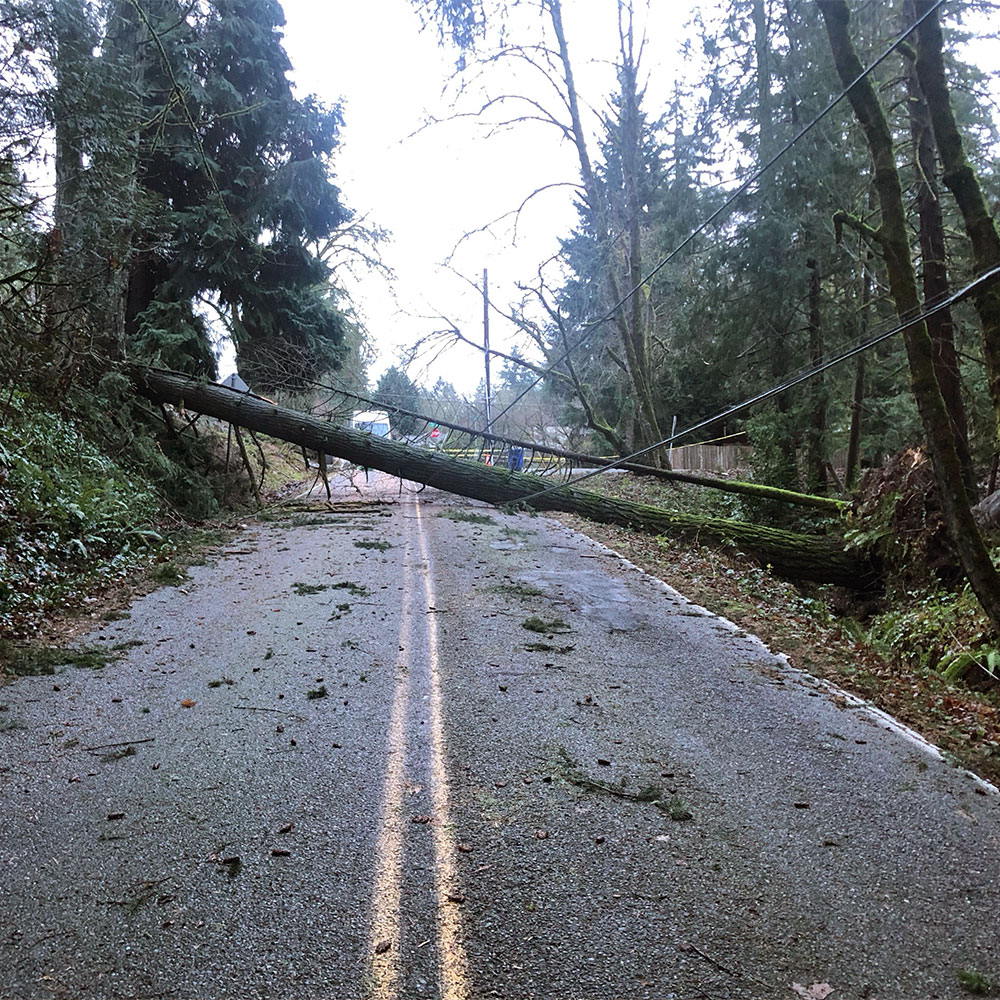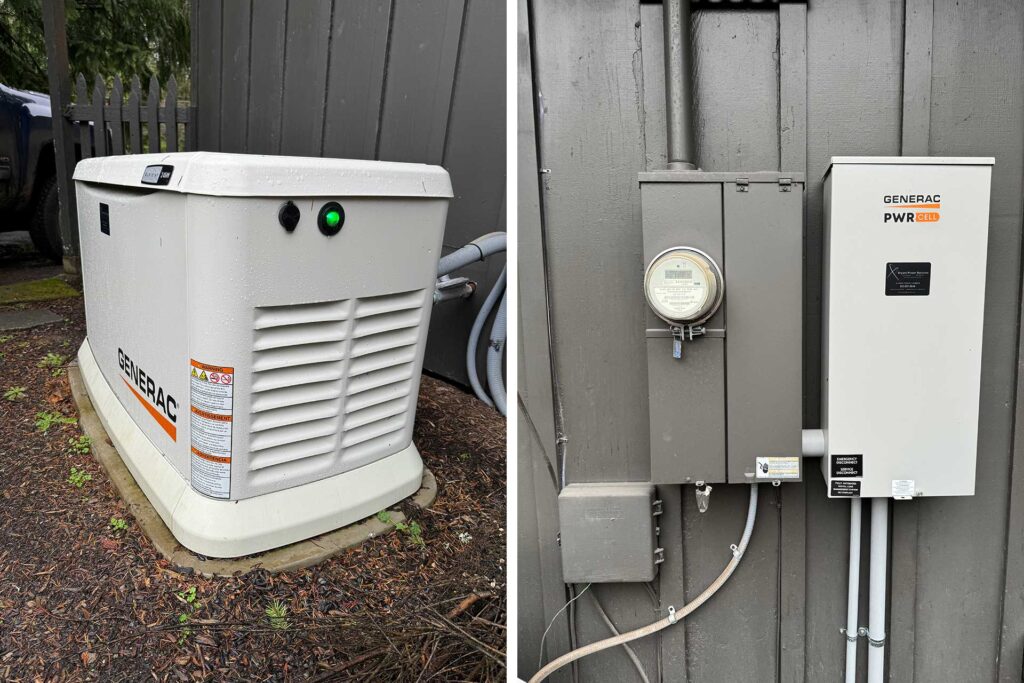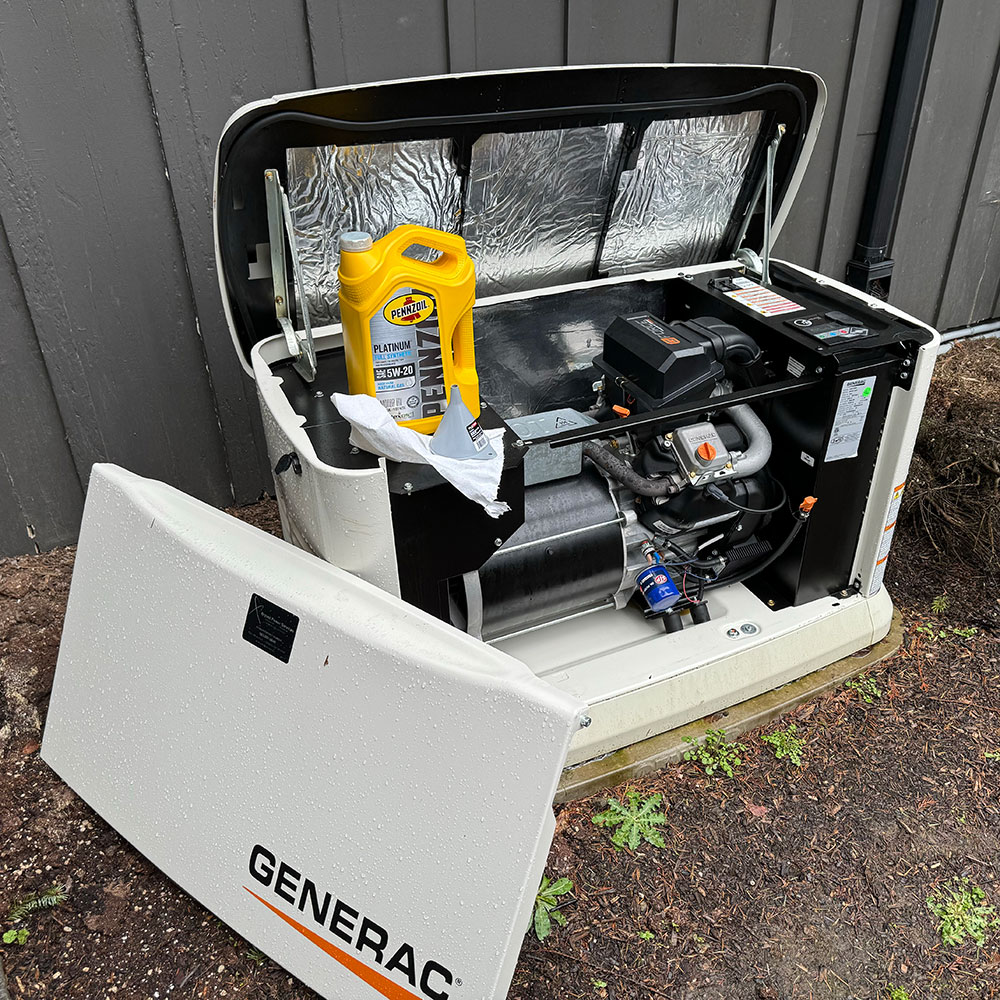
Here in Portland, we still have above-ground power lines. And plenty of trees. Given the extent of the existing electrical infrastructure and the likely cost of replacement, it is unlikely that PGE or Pacific Power will bury their lines any time soon. With damaging wind storms causing power outages seemingly multiple times a year, homeowners and businesses increasingly find themselves struggling to get through outages lasting more than 24 hours. As more people work from home, the focus on resilient, reliable home systems sharpens. Enter the whole house generator.
While we will discuss whole house generators for private homes here, similar considerations apply to businesses with their own buildings. Portable generators offer smaller capacity options that we will not discuss here.
What is a whole house generator?
In a power outage, a whole house generator senses the lack of power as soon as it drops. The system then rechecks that sensor to make sure it isn’t just a short gap. Meanwhile, it immediately runs a pre-start routine. If power remains off, it then kicks on within 30 seconds of initial drop to resume providing power to the property.
A whole house generator system consists of:
- An automatic transfer switch (ATS). Required in any installation, this switch isolates the property from the utility. It creates a direct connection from the generator to the home’s electric panel, bypassing the electric grid. This isolation protects against any generated charge from lighting up the overhead wires while line workers fix the outage.
- A generator with an internal combustion engine. This engine is similar to a conventional car engine, though less sophisticated.
- Independent fuel access. Fuel choices include either a natural gas connection through the property’s gas meter, or a storage tank for propane or diesel (above or below ground).

How do you size a whole house generator?
When deciding to purchase a generator, the main consideration is how much of your house and property you want to keep running. You don’t have to power the entire place. The most essential life safety systems to maintain are:
- HVAC,
- Domestic hot water,
- Refrigeration,
- Select lights, and
- Select outlets for corded small appliances or digital devices.
Alternately, homeowners can size the system to handle the whole property so that they can live as they normally would. While more expensive, a full capacity system removes any persnickety house management during the power outage. Think about whether you want to manage issues like: no clothes or dish washing; no light or power in certain zones of the house; or no heat in areas that may cause a pipe to freeze.
Given the cost to install a generator, a whole house system is increasingly the recommended strategy. Further, a fully sized generator will add value to any future sale of the property. Work with your local provider to assess the right size for your property.
How much does a whole house generator cost?
As an example: a 24kw generator system with 200amp electrical service could easily serve an entire property. This system currently retails for approximately $6,000 in various configurations from several manufacturers. Expect installation labor to match the equipment cost. So, for a safe estimate, double your equipment cost to budget the entire cost. Also, consider the cost of any fuel storage installations — tank, buried tank, new piping, etc. Often an electrician and an hvac contractor will partner to provide the materials and installation as a complete package.
What fuel should be the independent power source?
Local fuel options and pricing will drive the choice of which system to select. (While each of these options promote fossil fuel use, this is an emergency system that hopefully sees limited run time. We will address home resiliency with solar power and battery storage in a future post.)
- Natural gas
PROS: Piped underground to property – safe from trees and wind. Offers continuous flow and does not require a bulky storage facility. This is often a good option for urban properties.
CONS: Unlikely to survive a significant seismic event. Likely need to upsize the meter capacity for the property. - Propane
PROS: Independent of any infrastructure outages. Tank can be buried.
CONS: Tank size limits continuous use for long power outages. Storage tanks sized for residential lots often only serve a few days. Propane delivery may be limited during an outage. - Diesel
PROS: Independent of any infrastructure outages. Tank can be buried.
CONS: Tank size limits continuous use for long power outages. Storage tanks sized for residential lots often only serve a few days. Diesel availability may be limited during an outage, but is more easily self-sourced than propane.
What is the required maintenance for a whole house generator?
Generators require regular maintenance just like a car. Yearly tuneups with an oil change are recommended. Further, some require checking the oil level every 24 hours of run-time, so have extra engine oil on hand for a multi-day power outage.

Generators self-start every month to test and exercise their internal components. Many manufacturers now have wifi-enabled systems that can provide update status and run-time data. If you’re interested in wifi capabilities for your generator, remember to locate it in range of your home wifi setup.
Some things to know about living with a whole house generator (from people who live with one)
- Power isn’t maintained continuously from grid drop. Any electronic systems not protected by a UPS (uninterruptible power supply) will briefly lose power. Medical or business equipment requiring constant power should have a UPS backup. Other electronics should be protected, at the very least, by surge protectors.
- Generators take up space, usually outside. Sizes vary, but 5’L x 4’D x 3’H seems common. The generator will be located near your electrical service entry panel with space for service access. There are required separations to structures for fire protection and air intake/exhaust reasons. Size and configuration will vary per manufacturers’ criteria.
- They are LOUD, especially when the neighborhood is so quiet during an outage. This engine doesn’t have a quiet exhaust like a modern car. Sound attenuation solutions are available but expensive. Careful site location is the most economical option for mitigating sound impacts, but usually only most effective on larger lots. Talk to your architect about other alternatives if attenuating sound is crucial.
- While you don’t pay for electricity, you do pay for run-time in fuel costs. While this may seem like a shock on your monthly natural gas bill, it pales in comparison to the emergency plumbing bill to fix a frozen pipe in the middle of a winter storm.
- You can turn the generator off during a power event to save or manage fuel costs. Just be vigilant where the downtime might affect some critical home systems. If weather allows, sometimes it’s nice to turn the racket off overnight to sleep in the rare city silence of a power outage.
Invest in your property
If you live in an area that loses power more than once a year, you may want to consider adding a whole house generator to your home. You can avoid some of the unfortunate difficulties associated with power outages that we see in the evening news: frozen pipes in the winter (and attendant damage); food storage problems during the summer; or even last second hotel costs. A generator allows you to bridge the unfortunate weather events that cause temporary power outages with peace of mind.
